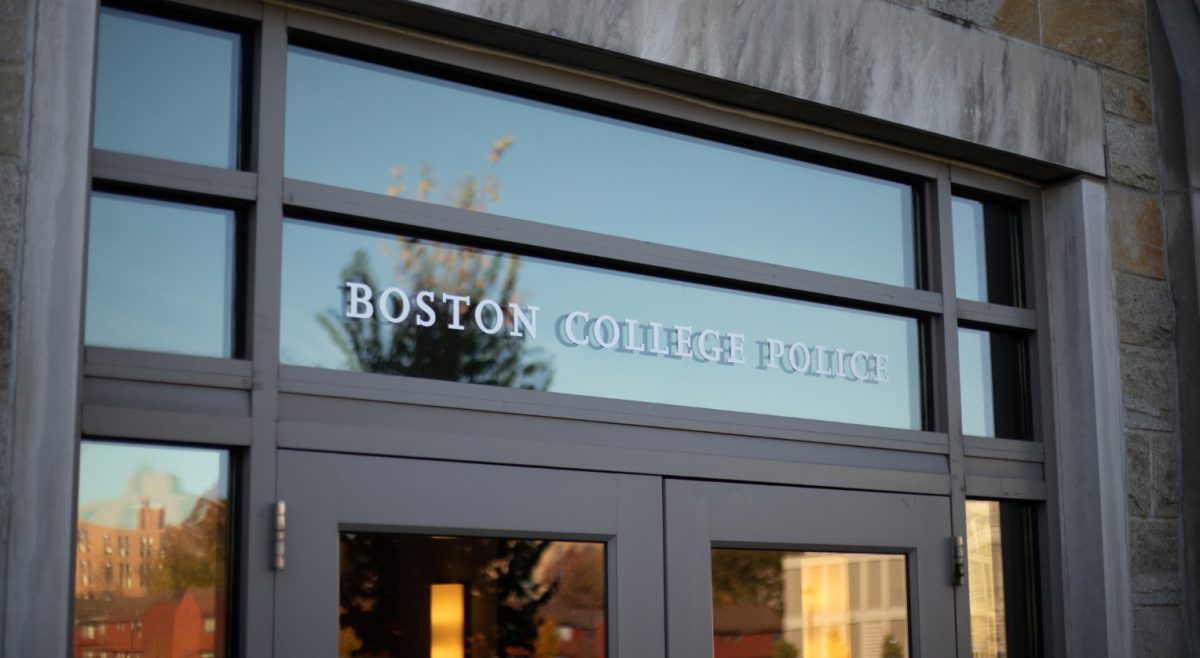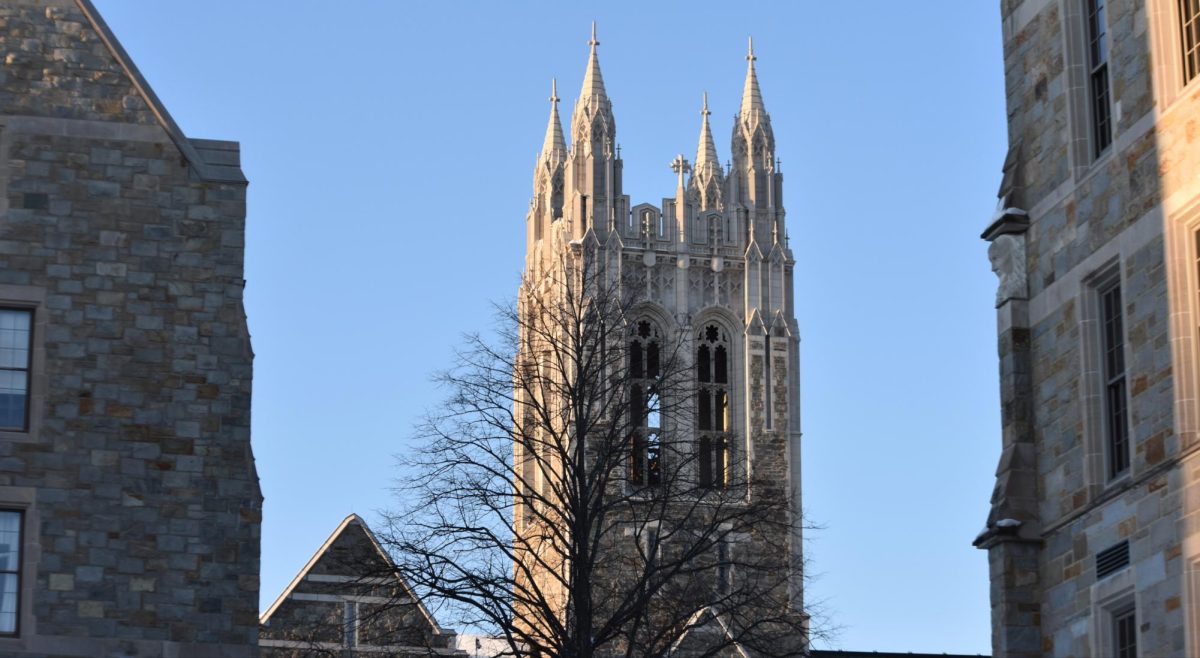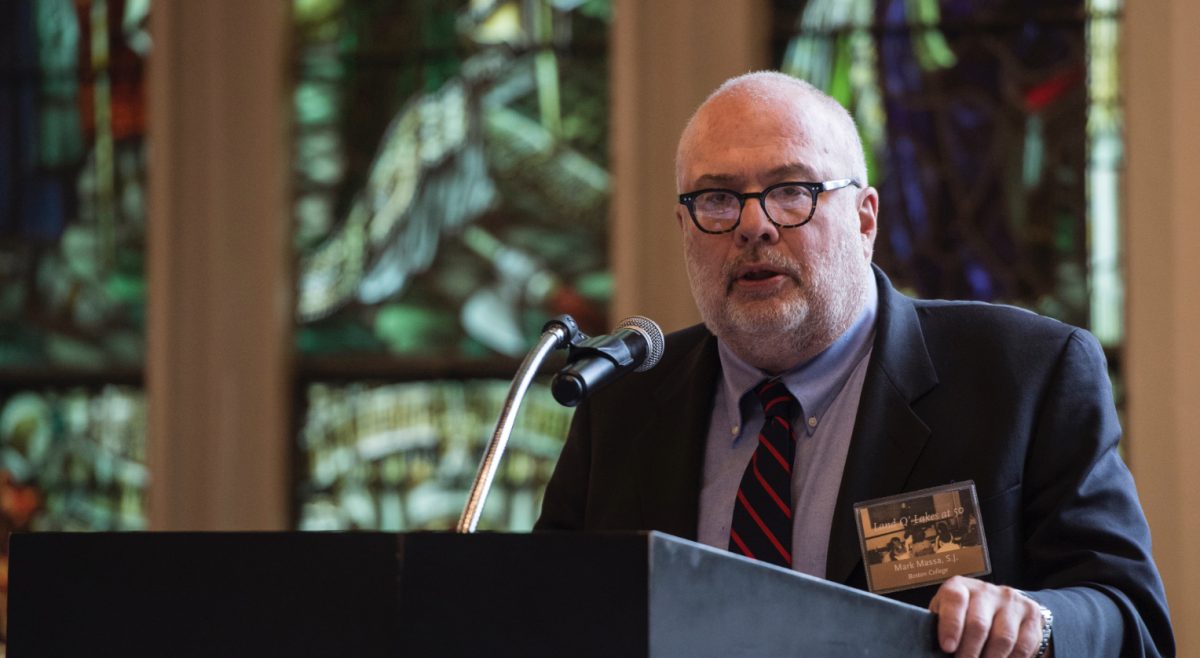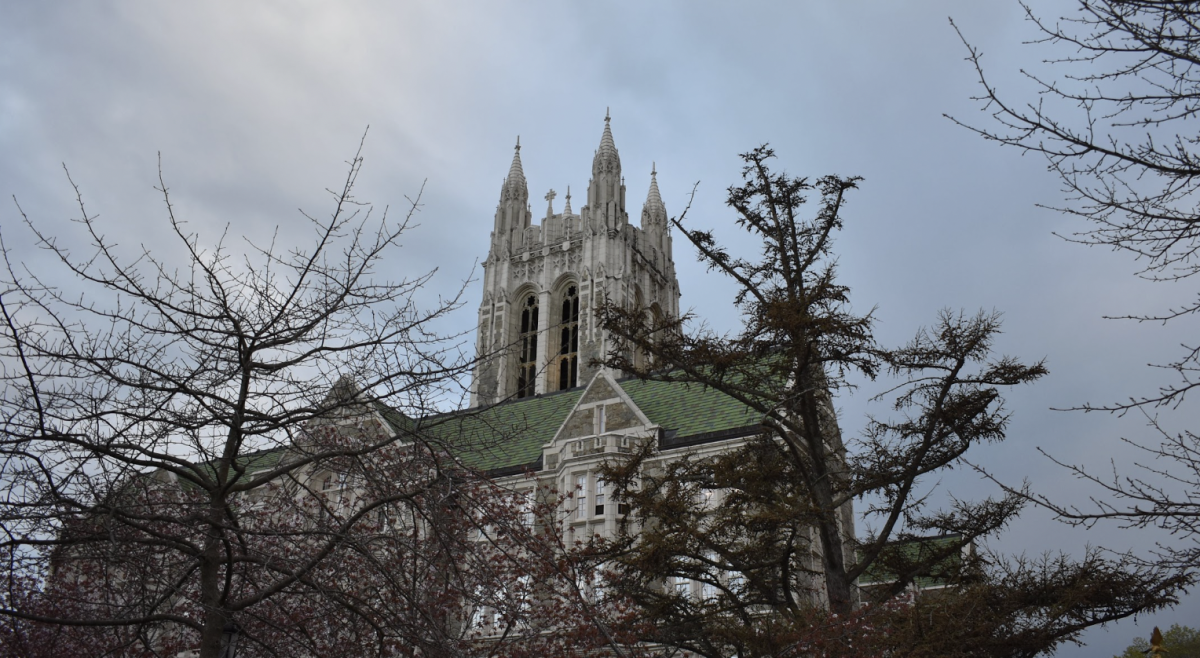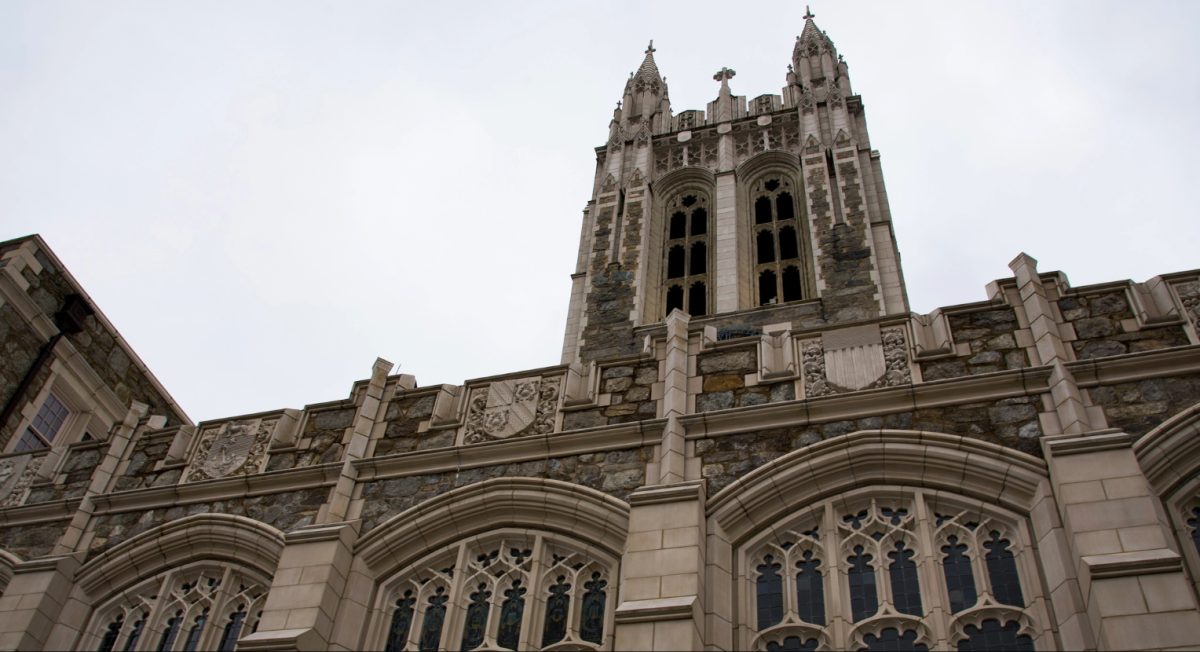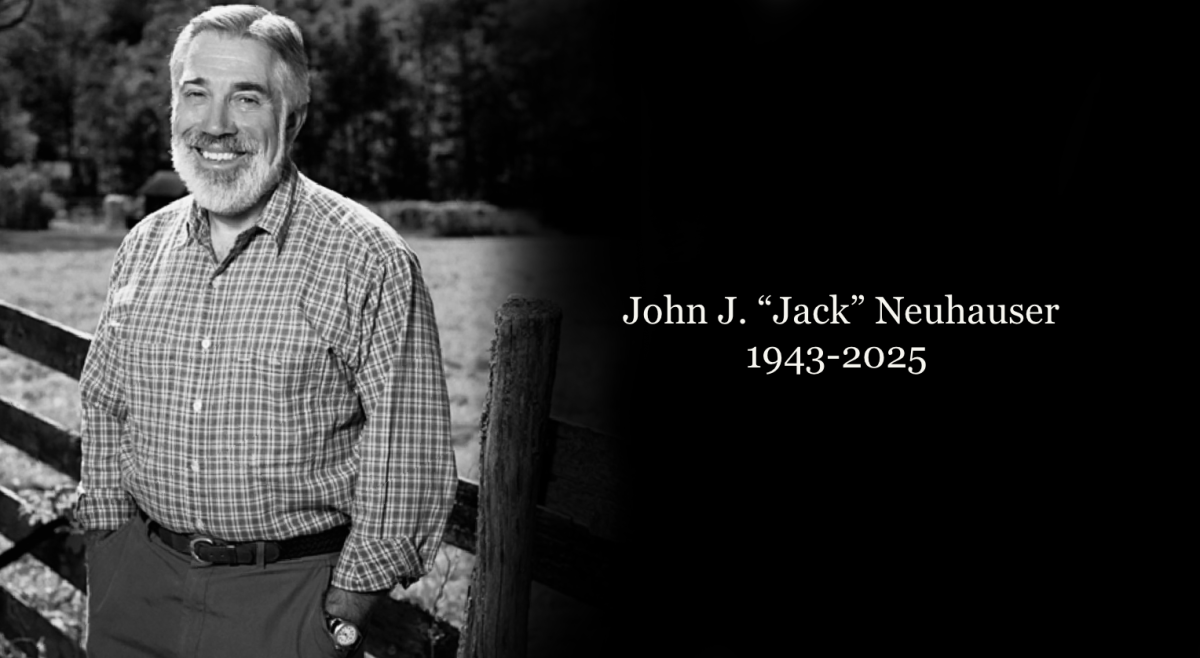In the penultimate year of Rev. Thomas I. Gasson, S.J.’s tenure as University president, Boston College relocated from its Harrison St. home in Boston’s South End to Chestnut Hill. When the move transpired in 1913, it was into what was then known only as the “Tower Building,” but is now eponymous for the president whose unflagging vision and resolute will was responsible for BC having a legitimate college campus. Most of the fixtures that now occupy the campus have been constructed in the 101 years since that move, but there are a few notable exceptions.
Certainly the most well known (and perhaps the oldest) is the statue of St. Michael the Archangel, towering over Satan, commissioned in 1865 for a wealthy Boston merchant only two years after the founding of the University. As the centerpiece of the Gasson rotunda, the statue has seen much of the University’s history.
There is another exception that, despite its relative youth, has undoubtedly seen more of history than any other fixture on the BC campus. Tucked away on the second floor of the Law Library on Newton campus, there is a marble mantel in the Daniel R. Coquillette Rare Book room that once adorned a fireplace in the East Room of the White House.
The story of that mantel tells much of the history of the White House during the first half of the 20th century. It was built in 1902 during the Roosevelt administration’s White House restoration by the architectural firm of McKim, Mead, and White under the direction of Charles McKim.
It was one of four mantels to occupy the 80-by-40 foot hall—the largest in the White House—that to this day serves as the executive mansion’s default room for large balls, signing ceremonies, dinners, and other functions of state. McKim did away with the Victorian trappings that had decorated the room (and much of the rest of the White House), and the new mantels were installed as a part of his vision to return the room to a late-18th century classical style.
During its time in the East Room, BC’s mantel saw many important moments—both national and intimate—in the years between the Roosevelt and Truman administrations. After moving back into the White House, Roosevelt held a Japanese jujitsu exhibition, as well as his daughter Alice’s wedding, in the room.
In the years that followed, the room played host to many skilled musical talents, including world-renowned pianist Sergei Rachmaninoff. In 1923, the casket of Warren G. Harding, 29th president of the U.S., laid in anticipation of burial in the East Room after his death, as many of his predecessors had before him.
The mantel’s transfer to BC was precipitated by the reconstruction of the White House during the administration of Harry S Truman, the 33rd president. After years of neglect during the Franklin Roosevelt administration, the house was in imminent danger of falling down on the Truman family.
The ceilings were sagging, brought down by the weight of the chandeliers and the weakness of the crossbeams—many of which had been in place since before White House fire during the War of 1812 and were left in place by the rushed McKim during the Roosevelt reconstruction.
It took several near misses, however, before Truman would decide to reconstruct the White House. One of those incidents occurred in the East Room itself, during a state dinner in February 1947. While a pianist played Chopin for Truman and his guests, the Secret Service approached the president and informed him that the chain that supported the 68-inch chandelier above his guests was in serious danger of breaking. Truman decided against alarming his guests, and, although the chandelier survived and was safely lowered the next day, it would take a few more incidents to convince the president that the building needed a complete overhaul.
When, in 1949, the renovation finally began, the Commission on the Renovation of the Executive Mansion was faced with deciding what to do with everything within the confines of the White House walls, the only part of the building not scheduled for demolition. Lorenzo Winslow, the White House architect, decided in August of 1949 that his plan for the reconstruction would bring the building back to the styling of the period of its construction—approximately 1800 to 1820. To meet this aesthetic vision, much of what had collected in the White House during its occupants by the 28 presidents since the fire could not be reused.
Since Congress had prohibited the Commission—and anyone else—from profiting off the remains of the building, they were forced to devise another method for disposing of the items that were not scheduled for reuse and were of no interest to museums. The Commission devised a four-tiered schedule for all of the debris, and the mantels from the East Room were scheduled as Class I—meaning they had “‘intrinsic as well as historical value.’”
It was left to the Commission’s executive director—Glen Edgerton, a retired Army general—to find homes for as much of the material as possible. Some of it was divvied up to connected members of the Washington establishment, but Edgerton actively sought a home for a large portion of the material. When most of the art museums he contacted—a list that included the Metropolitan Museum of Art in New York and the Museum of Fine Arts in Boston—declined the offer of a White House mantel, he turned to less renowned institutions.
It was not through an act of luck that BC came to own one of the discarded White House mantels. University President Rev. William L. Keleher, S.J., leaned on his political connections—as well as the Dean of the Law School, William J. Kenealy, S.J.—within the Boston community, which included the representative from the now-defunct 12th district, John McCormack, as well as George Hines, special representative in Washington for the Massachusetts Development and Industrial Commission. At the time, McCormack, a Democrat, served as the Majority Leader in the House of Representatives, and thus he exerted significant influence in Washington.
Housed in the University Archives within the Burns Library is some of the correspondence between Keleher—and then his successor as president, Rev. Joseph. R.N. Maxwell, S.J.—and McCormack, Hines, and Edgerton. Although the early communication between them that secured the fireplace for BC is missing, the remaining letters in the President’s Office Records of Joseph R.N. Maxwell, S.J., record the reception of the mantel in 1951. Hines wrote to Keleher on March 22 officially confirming that BC would receive what he considered to be “the most beautiful one of the nine fireplaces taken from the White House.” He also later sent Keleher two photographs (the bottom left in the photo spread is one of them) of the mantel in the East Room, right before it was removed.
The fireplace was BC’s for the cost of crating, shipping, and insurance, which, in 1953,Hines estimated at $75. After Hines secured additional marble that had surrounded the fireplace, a shipment of 4,500 pounds, which included “the fireplace, the mirror frame, the red marble hearthstone, the iron bottom, side and decorated back plates and the pilasters that surround the fireplace and mirror frame from the East Room of the White House” left Washington in 12 to 15 boxes at the end of March. With the additional material, the final cost to BC was $200.
The East Room mantel was not, however, the first choice of Keleher. A letter between McCormack and Hines included in the file reveals that Keleher originally requested a mantel from the Lincoln Room, but that “the commission is under pressure from museums in Illinois for this fireplace and preferred to give BC another.” Hines then suggested to Keleher that BC accept the mantel from the East Room.
When the University took receipt of the mantel in 1951, Keleher did not yet have a place in mind on campus to locate the White House relic. It was only in 1953 that a suitable location was found the new Law School building being constructed on the Chestnut Hill campus, the recently demolished St. Thomas More Hall.
Upon the building’s completion, the mantel was installed in the Roberts Room (top right photo in the spread)—named after Vincent and Mary Roberts, who donated the money to purchase the land upon which the building was situated from the city—which served as a lounge for the law faculty.
It remained in that room until the Law School departed for the newly acquired Newton Campus in the fall of 1975. After the Law School departed over the summer, St. Thomas More Hall was repurposed into administrative offices and undergraduate student study space. The fireplace relocated with the law school, first to Stuart Hall and, after the new Law Library was built in 1996, to the Law Library, where it rests to this day.
Featured Image by Andrew Skaras / Heights Editor


